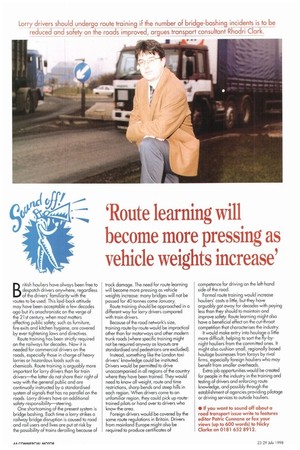Lorry drivers should undergo route training if the number of
Page 46

If you've noticed an error in this article please click here to report it so we can fix it.
bridge-bashing incidents is to be reduced and safety on the roads improved, argues transport consultant Rhodri Clark.
'Route learning will become more pressing as vehicle weights increase'
British hauliers have always been free to despatch drivers anywhere, regardless of the drivers' familiarity with the routes to be used. This laid-back attitude may have been acceptable a few decades ago but it's anachronistic on the verge of the 21st century, when most matters affecting public safety, such as furniture, fire exits and kitchen hygiene, are covered by ever-tightening laws and directives
Route training has been strictly required on the railways for decades. Now it is needed for commercial drivers on the roads, especially those in charge of heavy lorries or hazardous loads such as chemicals. Route training is arguably more important for lorry drivers than for train drivers—the latter do not share their right of way with the general public and are continually instructed by a standardised system of signals that has no parallel on the roads. Lorry drivers have an additional safety responsibility—steering. One shortcoming of the present system is bridge bashing. Each time a lorry strikes a railway bridge disruption is caused to road and rail users and lives are put at risk by the possibility of trains derailing because of track damage. The need for route learning will become more pressing as vehicle weights increase: many bridges will not be passed for 40 tonnes come January.
Route training should be approached in a different way for lorry drivers compared with train drivers.
Because of the road network's size, training route-by-route would be impractical other than for motorways and other modern trunk roads (where specific training might not be required anyway as layouts are standardised and pedestrians are excluded). Instead, something like the London taxi drivers' knowledge could be instituted. Drivers would be permitted to drive unaccompanied in all regions of the country where they have been trained. They would need to know all weight, route and time restrictions, sharp bends and steep hills in each region. When drivers come to an unfamiliar region, they could pick up routetrained pilots or hand over to drivers who know the area.
Foreign drivers would be covered by the same route regulations in Britain. Drivers from mainland Europe might also be required to produce certificates of competence for driving on the left-hand side of the road.
Formal route training would increase hauliers' costs a little, but they have arguably got away for decades with paying less than they should to maintain and improve safety. Route learning might also have a beneficial effect on the cut-throat competition that characterises the industry. It would make entry into haulage a little more difficult, helping to sort the fly-bynight hauliers from the committed ones. It might also cushion small, regionally based haulage businesses from forays by rival firms, especially foreign hauliers who may benefit from smaller overheads.
Extra job opportunities would be created for people in the industry in the training and testing of drivers and enforcing route knowledge, and possibly through the establishment of agencies providing pilotage or driving services to outside hauliers.
• If you want to sound off about a road transport issue write to features editor Patric Cunnane or fax your views (up to 600 words) to Nicky Clarke on 0181 652 8912.




































































































